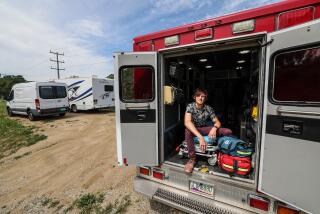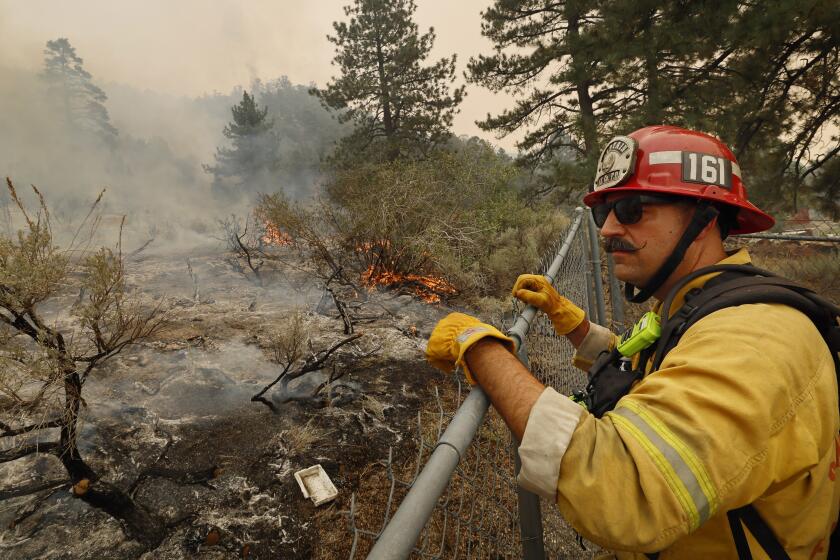Post-Katrina cottages get a lukewarm welcome
When a New York designer came up with a plan for a tiny cottage that could offer permanent shelter for Gulf Coast residents displaced by Hurricane Katrina, Mississippi officials pressed hard for federal funding.
Why build a flimsy government trailer, they asked, when it was possible to build a sturdy, long-lasting cottage -- especially one as charming as the “Katrina cottage,” designed in a Southern vernacular style, with a steep metal roof and a deep front porch?
But now that the “Mississippi cottage,” a small shotgun-style house inspired by the original, is rolling onto the coast, things have become a little more complicated: The Mississippi Emergency Management Agency provides only the cottage -- not the land -- and cities have imposed rule after rule to keep qualified residents from settling into them.
Local officials, it seems, fear that the brightly colored cottages will become permanent fixtures in their hurricane-ravaged neighborhoods. They say the cottages, which range from 400 to 840 square feet and cost as little as $34,000 to build, will hurt property values.
And so the cottage that was designed to offer long-term shelter is now being used strictly temporarily -- and in many cases not by people who seem to need it most.
So far, more than 900 families on the Mississippi coast have moved into the cottages as part of a national pilot program to determine whether those units make better emergency housing than trailers. Yet while there is no shortage of residents who want to move in, many local officials are reluctant to concede that the cottages represent a step up.
“The Mississippi cottage is a trailer -- except that instead of coming in through the side, you come in through the front,” said Jim Thriffiley, president of the Bay St. Louis City Council, which has approved 69 applications for cottages and rejected many more. “We don’t want the stigma of these homes in our community.”
The battle stems in part from the fundamental question of whether the cottage is a transitional or long-term housing solution.
In principle, the cottage can serve both needs, said Mike Womack, the executive director of the state emergency agency. Under the pilot program, the cottages are constructed off-site, wheeled in and strapped to concrete blocks as a temporary measure, their wheels left dangling in midair. The cottages are exempt from flood-elevation regulations.
Yet Womack said there was no reason the structures, which have a 30-year warranty, could not provide a long-term solution. The agency had hoped to allow tenants the opportunity to purchase the cottages and convert them into permanent homes by elevating them to meet flood requirements, but that plan has been up to city councils. “We did not expect resistance to be this strong,” Womack said.
While cities along the coast have imposed cottage restrictions, debate has been especially heated in Bay St. Louis. With most of the resort town’s historic beachside homes gone, the City Council has been trying to prevent the cottages from taking root in what had been its most valuable neighborhoods.
At first, council members stipulated that cottages be allowed only in commercially zoned trailer parks, but they relented after those who had lost their homes pleaded for cottages to live in while they rebuilt. Residents can now put cottages on residential lots -- but only if they already live in a Federal Emergency Management Agency trailer, own property and can demonstrate that they are actively trying to rebuild.
That excludes residents like Stacey Loftin, 33, who rented before the 2005 hurricane and has been living with her three children in a FEMA trailer in her mother’s frontyard. Loftin was thrilled when a Mississippi official said she qualified for a cottage, but then the Bay St. Louis City Council told her she could not put a cottage in her mother’s backyard. “I just wanted to cry,” she said. “I’m not trying to beat the system. I work 40-plus hours a week. And still I can’t get a break.”
The state has promised to remove the cottages by March 2009. Yet opposition has not abated.
Last month, Gov. Haley Barbour met with local officials and pleaded with them to welcome the cottages as a safer alternative to the trailers.
The standoff is troublesome for Mississippi, which fought hard for federal funding. FEMA is prohibited from paying for what is considered “permanent” housing, but last year Congress agreed to fund a $280-million national pilot program, run by the Mississippi Emergency Management Agency, to determine whether the cottages would make viable disaster housing.
Meanwhile, Louisiana received $75 million in federal funds for a separate effort -- construction of four long-term cottage communities. Because officials have come under fire for the delays in the project, no one has moved into the cottages. Yet some believe the Louisiana plan -- which involves 600 elevated modular cottages -- could provide a more thoughtful long-term solution.
Designer Marianne Cusato, who came up with the prototype for the Katrina cottage, is working with Louisiana officials to set up a cottage community there. Although she is not involved with the Mississippi project, she said it was not practical to expect everyone to move out of those cottages by March 2009. Because the reality is that the cottages -- conceived as permanent housing -- will likely not be as temporary as officials want them to be, she said, it is crucial that they be installed to flood elevation requirements.
Acceptance of the cottages has become particularly pressing in Mississippi as FEMA attempts to evict more than 12,500 families from trailers. Amid growing concern that the trailers may contain toxic formaldehyde fumes, the agency has suspended the sale of its used trailers and has said it won’t house victims of future disasters until safety issues are resolved.
In Gulfport, where a Dec. 31 deadline has been imposed for residents to move out of trailer parks, FEMA officials say they are struggling to find suitable rental accommodations for 329 families. City officials will not allow the cottages to be installed in the trailer parks.
Nearly half of those living on the Gulf Coast before Katrina lived in rentals, but only about one-tenth of housing funds have gone toward rebuilding rental units.
With rents higher by at least 30%, many worry about those who can’t afford a new place to live.
“If you have a decent bone in your body, a Christian bone in your body, how can you tell someone living in a FEMA village that you can’t put them in a cottage?” said Tommy Longo, mayor of the adjoining city of Waveland. “I can’t do that.”
Yet those who oppose the cottages -- particularly property owners who have struggled to rebuild -- say they are defending the future of their communities. Be honest, they say: Would you want a shotgun home on wheels rolling into your neighborhood?
“People say we’ve got obligations for affordable housing, but this is a community that has to get moving,” said Thriffiley. “What’s happening is that people who have not paid rent or utilities for 2 1/2 years just want to keep on having a free ride.”
And so, while the Katrina cottage has won warm reviews across the country -- Lowe’s home-improvement stores began retail sales of several models this year -- its future remains uncertain in Mississippi.
“The cottage doesn’t solve the housing problem,” said Jim Taylor of Bay St. Louis who has nearly finished rebuilding his home on Sycamore Street. “Yes, they might be more comfortable than a trailer, but they’re still just a stopgap measure. They’re not as comfortable as a real home.”
Yet Cusato has faith in the Katrina cottage concept. If the program is running into problems, she said, it isn’t because the cottages are too small or are not a viable housing option: “It all has to be thought out. If what Mississippi is building isn’t actually, physically, a long-term solution, it doesn’t work.”
More to Read
Sign up for Essential California
The most important California stories and recommendations in your inbox every morning.
You may occasionally receive promotional content from the Los Angeles Times.











